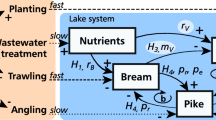Abstract
It is shown with the use of minimal models that several ecological relationships in freshwater systems potentially give rise to the existence of alternative equilibria over a certain range of nutrient values. The existence of alternative stable states has some implications for the management of such systems. An important consequence is that signs of eutrophication are only apparent after the occurrence of changes that are very difficult to reverse. Reduction of the nutrient level as a measure to restore such systems gives poor results, but biomanipulation as an additional measure can have significant effects, provided that the nutrient level has been reduced enough to allow the existence of a stable alternative clear water equilibrium.
Similar content being viewed by others
References
Anderson, R. M., 1981. Population ecology of infectious disease agents. In R. M. May (ed.), Theoretical Ecology. Blackwell, Oxford: 318–356.
Andersson, G., H. Berggren, G. Cronberg & C. Gelin, 1978. Effects of planktivorous and benthivorous fish on organisms and water chemistry in eutrophic lakes. Hydrobiologia 59: 9–15.
Benndorf, J. & H. Kneschke, 1984. Manipulation of the pelagic food-web by stocking with predacious fishes. Int. Revue ges. Hydrobiol. 69: 407–428.
Crivelli, A. J., 1983. The destruction of aquatic vegetation by carp. Hydrobiologia 106: 37–41.
Diehl, S., 1988. Foraging efficiency of three freshwater fishes: effects of structural complexity and light. Oikos 53: 207–214.
Gatto, M. & S. Rinaldi, 1987. Some methods of catastrophic behaviour in exploited forests. Vegetation 69: 213–222.
Gerking, S. D. (ed), 1978. Ecology of Freshwater Fish Production, Blackwell, London, 520 pp.
Grimm, M. P., 1989. Northern pike (Esox lucius L.) and aquatic vegetation, tools in the management of fisheries and water quality in shallow waters. Hydrobiol. Bull. 23: 59–67.
Holt, R. D., 1977. Predation, apparent competition, and the structure of prey communities. Theoret. Population Biol. 12: 197–229.
Hosper, S. H., 1989. Biomanipulation, new perspective for restoring shallow, eutrophic lakes in The Netherlands. Hydrobiol. Bull. 23: 5–11.
Lazarro, X., 1987. A review of planktivorous fishes: their evolution, feeding behaviours, selectivities and impacts. Hydrobiologia 146: 97–167.
Ludwig, D., D. D. Jones a C. S. Holling, 1978. Qualitative analysis of insect outbreak systems: the spruce budworm and forest. J. anim. Ecol. 47: 315–332.
May, R. M., 1977. Thresholds and breakpoints in ecosystems with a multiplicity of stable states. Nature 269: 471–477.
May, R. M., 1981. Models for two interacting populations. In: R.M. May (ed), Theoretical ecology. Blackwell, Oxford: 78–105.
Meijer, M.-L., M. W. de Haan, A. W. Breukelaar, H. Buiteveld, 1990. Is reduction of the benthivorous fish an important cause of high transparency following biomanipulation in shallow lakes? Hydrobiologia 201/202: 303–315.
Moss, B., H. Balls, I. Booker, K. Manson & M. Timms, 1984. The River Bure, United Kingdom: patterns of change in chemistry and phytoplankton in a slow-fertile river. Verh. int. Ver. Limnol. 22: 1959–1964.
Noy-Meir, I., 1975. Stability of grazing systems: an application of predator-prey graphs. J. Ecol. 63: 459–483.
Oksanen, L., S. D. Fretwell, J. Arruda & P. Niemela, 1981. Exploitation ecosystems in gradients of primary productivity. Am. Nat. 118: 240–261.
Rosenzweig, M. L., 1971. Paradox of enrichment: Destabilization of exploitation ecosystems in ecological time. Science 171: 385–387.
Rosenzweig, M. L., 1973. Exploitation in three trophic levels. Am. Nat. 107: 275–294.
Rosenzweig, M. L. & R. H. MacArthur, 1963. Graphical representation and stability conditions of predator-prey interactions. Am. Nat. 895: 209–223.
Scheffer, M., submitted. Fish and nutrients interplay determines algal biomass: a minimal model. Limnol. Oceanogr.
Scheffer, M., 1989. Alternative stable states in eutrophic shallow freshwater systems: a minimal model. Hydrobiol. Bull. 23: 73–85.
Spence, D. H. N., 1982. The zonation of plants in freshwater lakes. In A. Macfayden & E. D. Ford (eds.), Advances in ecological research, Volume 12. Academic Press, London: 37–125.
Ten Winkel, E. H. & J. T. Meulemans, 1984. Effects of cyprinid fish on submerges vegetation. Hydrobiol. Bull. 18: 157–158.
Thom, R., 1975. Structural stability and morphogenesis; an outline of a general theory of models. Benjamin, Reading, MA.
Timms, R. M. & B. Moss, 1984. Prevention of growth of potentially dense phytoplankton populations by zooplankton grazing in the presence of zooplanktivorous fish in a shallow wetland ecosystem. Limnol. Oceanogr. 29: 472–486.
Van Donk, E., R. D. Gulati & M. P. Grimm, 1989. Food-web manipulation in Lake Zwemlust: positive and negative effects during the first two years. Hydrobiol. Bull. 23: 19–35.
Wium-Andersen, S., 1987. Allelopathy among aquatic plants, Arch. Hydrobiol. Beih. 27: 167–172.
Author information
Authors and Affiliations
Rights and permissions
About this article
Cite this article
Scheffer, M. Multiplicity of stable states in freshwater systems. Hydrobiologia 200, 475–486 (1990). https://doi.org/10.1007/BF02530365
Issue Date:
DOI: https://doi.org/10.1007/BF02530365




